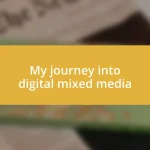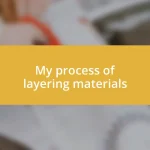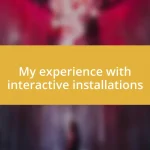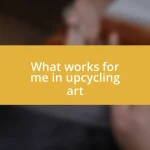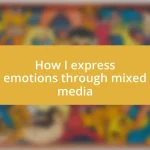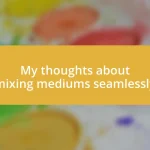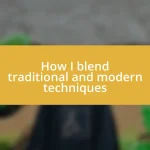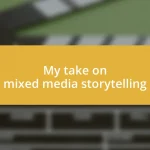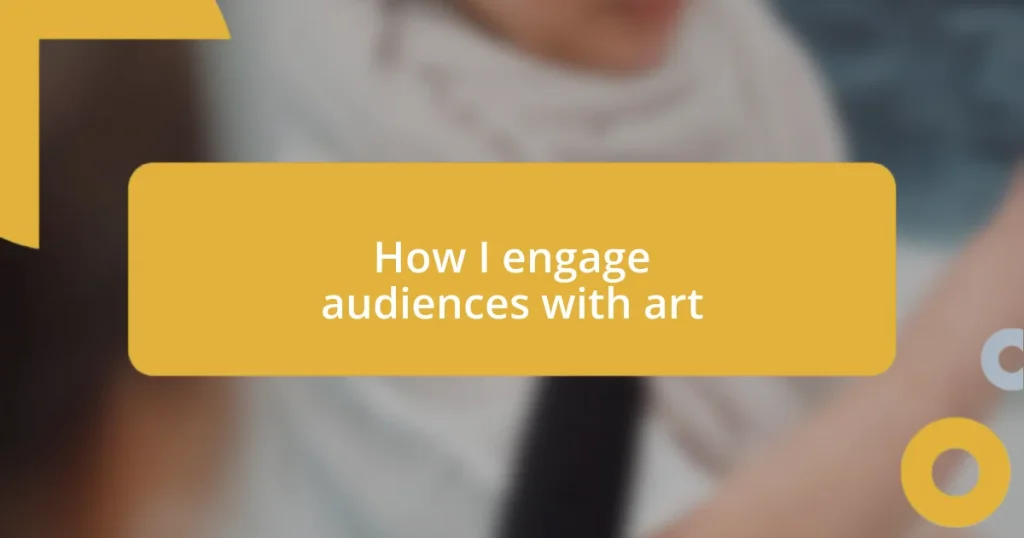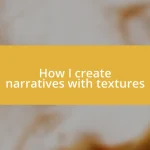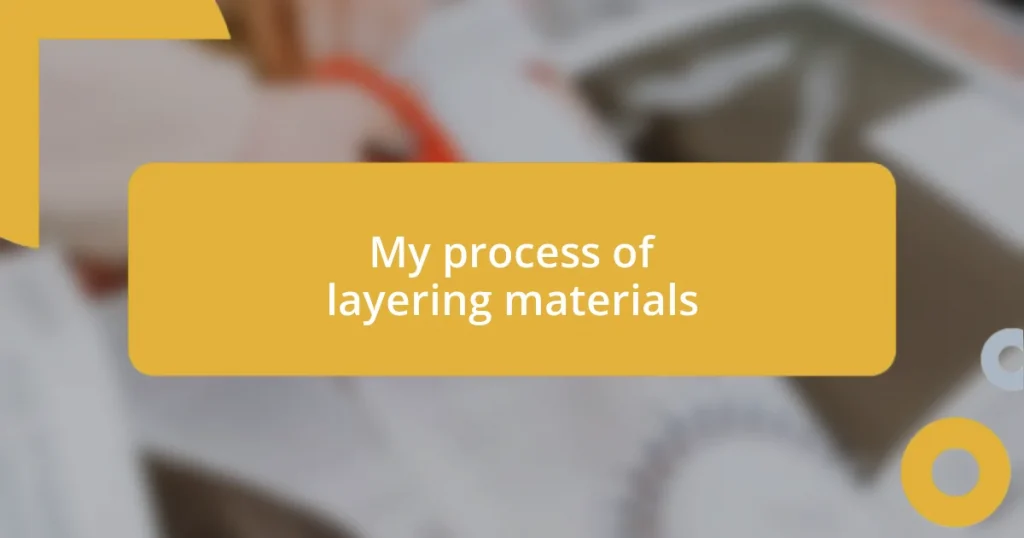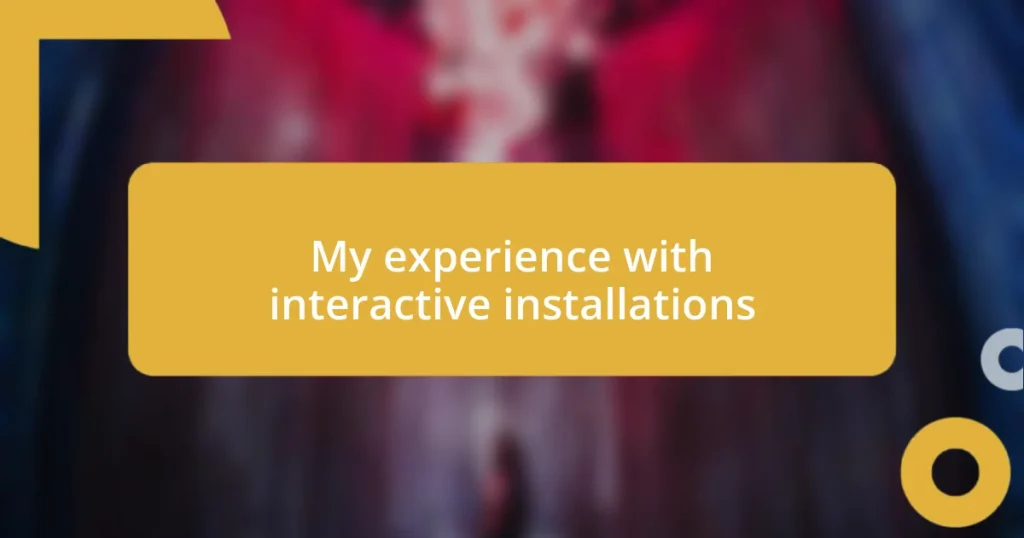Key takeaways:
- Engaging audiences involves understanding their reactions and encouraging dialogue through art, transforming the experience into a communal one.
- Choosing the right medium and incorporating interactive elements, such as augmented reality and collaborative projects, can enhance connection and participation.
- Building a community through art fosters a sense of belonging, encouraging diverse perspectives and shared narratives that deepen connections among individuals.

Understanding audience engagement
Understanding audience engagement starts with truly listening to your audience’s reactions and needs. I remember a time when I exhibited a collection of pieces inspired by local history; the way attendees opened up and shared their stories enriched the experience for everyone involved. Have you ever noticed how a slight shift in emotion can transform the dynamics in a room?
It’s fascinating how every individual brings their own perspective to a piece of art. When I hosted a workshop, I encouraged participants to interpret the artwork in their own way, leading to an unexpected yet vibrant discussion. What if we approached art not just as creators but as facilitators of insightful dialogue?
I often think about the power of a shared experience. In my own practice, I’ve seen how interactive elements can draw people in, igniting curiosity and connection. Isn’t it amazing how art can act as a bridge between diverse backgrounds and stories, creating a community out of simple brushstrokes and colors?

Choosing the right art medium
Choosing the right art medium is essential for connecting with your audience. I’ve often found that the medium I select can either invite engagement or create barriers. For instance, when experimenting with mixed media in one of my exhibits, I noticed how the varied textures sparked curiosity. Attendees would reach out to touch the piece, creating a more intimate interaction.
Here are some considerations I keep in mind when choosing a medium:
– Audience Preferences: What materials resonate with them?
– Emotional Impact: Does the medium evoke the intended feelings?
– Accessibility: Is the medium relatable and easy to approach?
– Personal Connection: Does the medium reflect my own experiences and stories?
– Interactivity: Can the medium invite participation or collaboration?
Throughout this journey, I reminisce about hosting a live sculpture demonstration. The audience’s excitement was palpable as they saw the process unfold, highlighting how the medium not only shapes the message but also defines the connection we build with others.

Incorporating interactive elements
Incorporating interactive elements into art can turn passive viewers into active participants. I once set up an installation where visitors could manipulate the lighting and sound effects. Watching someone’s face light up as they created their own atmosphere was immensely rewarding. It reinforced my belief that art should foster personal connections, transforming a solitary experience into a communal one.
One technique I love is using augmented reality (AR) in my exhibits. When people can use their phones to unlock additional layers of meaning in the artwork, it sparks their curiosity. I remember the excitement in the room when attendees discovered hidden stories and animations through AR. It was as if the art came to life, enriching their understanding and engagement.
To further enrich the interactive experience, I often integrate collaborative projects, inviting the audience to contribute to a piece over time. For example, in a community mural project, each participant added their own touch, creating a tapestry of diverse expressions. This collaborative approach not only builds community but also makes every individual feel valued in the artistic process.
| Interactive Element | Description |
|---|---|
| Manipulation of Environment | Allows viewers to change aspects like light and sound in real-time. |
| Augmented Reality | Engages audiences by revealing hidden stories and layers through technology. |
| Collaborative Projects | Encourages community participation, making everyone feel part of the art-making process. |

Leveraging social media platforms
Social media platforms have become an essential canvas for artists looking to engage with a wider audience. I remember when I shared a time-lapse video of my mural process on Instagram; the flood of comments and shares was exhilarating. It made me realize how powerful a simple post can be—not just in showcasing art, but in inviting dialogue. Have you ever thought about how a single tweet or post could spark a conversation that lasts much longer?
I often take advantage of platforms like TikTok to show behind-the-scenes moments that traditional galleries can’t provide. The real-time reactions and interactions from viewers bring a sense of excitement and immediacy to my art. I sometimes wonder, how many people have had their day brightened by a quick peek into my creative process? It’s incredible to imagine reaching someone thousands of miles away with just a video snippet.
Additionally, social media allows me to tap into specific communities that share my artistic vision. For instance, I initiated a themed challenge on Facebook, where followers created their interpretations of a concept I had introduced. Watching the diverse artworks roll in was like opening a treasure chest of creativity. It proved that leveraging social media isn’t just about promoting one’s art; it’s about building a family of artists and art enthusiasts who inspire one another.

Hosting live art events
Hosting live art events can be an exhilarating way to connect with an audience. I vividly recall a night under the stars when I organized an outdoor painting event, complete with live music and food trucks. Seeing strangers come together, laughing and sharing ideas as they painted side by side, was a reminder of how art has the power to foster community. Have you ever felt that electric atmosphere when creativity is unleashed in a shared space?
One of my favorite aspects of live events is the spontaneity they bring. I once hosted a “create as you go” session where participants were encouraged to join in at any time with their own materials. Witnessing a shy attendee turn into a passionate creator, boldly adding vibrant splashes of color to a large canvas felt like witnessing transformation firsthand. It made me reflect on how a welcoming environment can draw out hidden talents, and I often wonder, what stories do each of those individuals carry with them?
Moreover, incorporating performance art into these live gatherings elevates the experience even further. During one event, I collaborated with local dancers who interpreted the visual art unfolding before the audience. The way the movement and colors interacted was mesmerizing, creating a dynamic dialogue between the mediums. It left both the performers and the audience in awe, reinforcing my belief that art is not just a solitary journey but a vibrant, collective experience. What happens when we let different art forms collide? Magic, I think.

Analyzing audience feedback
Analyzing audience feedback is a crucial step in honing my artistic practice. I often turn to direct comments and suggestions left by viewers on my social media posts or at live events. For instance, after sharing a new series of paintings, one viewer’s insight about the emotional impact of color choices really stuck with me. It made me question my own creative decisions and opened the door for deeper exploration within my work. Have you ever had a piece of feedback completely shift your perspective on something you thought was set in stone?
I’ve also found that qualitative feedback can often reveal trends I wouldn’t notice otherwise. During a recent exhibition, I set up a feedback wall where attendees could share their thoughts anonymously. The overwhelming response about the themes of resilience and connection in my artwork was enlightening. It got me thinking: how can I further tap into these resonances in future projects? This kind of audience engagement not only boosts my confidence but also creates a meaningful dialogue around the themes I want to explore.
Additionally, analyzing feedback isn’t just about collecting data; it’s about feeling the pulse of my audience’s emotions. I remember reading a heartfelt message from someone who felt understood through my art during a difficult time. It hit me profoundly and reminded me why I create in the first place: to connect and inspire. These moments of recognition fuel my creativity. How powerful is it to know that my work can reach into someone else’s heart? It’s nothing short of magical.

Building a community through art
Building a community through art is like weaving a vibrant tapestry of diverse perspectives and experiences. I remember leading a mural project that invited local residents to contribute their own ideas about what home means to them. The initial hesitance quickly transformed into excitement as individuals picked up brushes, creating a stunning blend of colors and stories that reflected our shared identity. Isn’t it fascinating how art can serve as a mirror, revealing both the individual and the collective?
During another project, I collaborated with a group of young artists from different backgrounds. We held regular brainstorming sessions where each voice was valued equally, fostering a sense of belonging. Watching them ignite each other’s creativity was heartwarming; it’s incredible how art can empower people and cultivate a supportive network. I often ask myself, what happens when we provide a platform for underrepresented voices? The answer seems clear: we gain richness, depth, and unity.
Engaging with the community doesn’t stop at the artwork itself; it extends to sharing the narrative behind each piece. I once hosted a storytelling night where participants narrated personal tales related to the theme of our exhibition. The connections formed were palpable, leaving attendees feeling more like friends than strangers. How deeply can shared stories resonate within a community? I believe the answer lies in the friendships forged and the understanding deepened through our collective artistic journeys.
